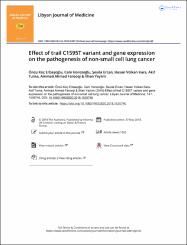| dc.contributor.author | Koç Erbaşoğlu, Öncü | |
| dc.contributor.author | Horozoğlu, Cem | |
| dc.contributor.author | Ercan, Şeyda | |
| dc.contributor.author | Kara, Hasan Volkan | |
| dc.contributor.author | Turna, Akif | |
| dc.contributor.author | Farooqi, Ammad Ahmad | |
| dc.contributor.author | Yaylım, İlhan | |
| dc.date.accessioned | 2020-05-26T21:17:16Z | |
| dc.date.available | 2020-05-26T21:17:16Z | |
| dc.date.issued | 2019 | en_US |
| dc.identifier.issn | 1993-2820 | |
| dc.identifier.issn | 1819-6357 | |
| dc.identifier.uri | https://hdl.handle.net/11363/2163 | |
| dc.description | Document Information
Language:English
Accession Number: WOS:000451538800001
PubMed ID: 30481147 | en_US |
| dc.description.abstract | It is known that disorders in apoptosis function play an important role in the pathogenesis of many types of cancer, including lung cancer. Tumor necrosis factor related apoptosis inducing ligand (TRAIL), a type II transmembrane protein, is a death ligand capable of inducing apoptosis by activating distinctive death receptor. Our purpose in this study is to investigate the gene polymorphisms in TRAIL molecular pathway and TRAIL gene expression levels in non-small cell lung cancer (NSCLC) patients in terms of pathogenesis and prognosis of the disease. In this study, TRAIL C1595T polymorphism was genotyped using polymerase chain reaction-restriction fragment length polymorphism analysis in 158 patients with NSCLC and 98 healthy individuals. Surgically resected tissues were examined and classified histopathologically. In addition, TRAIL gene expression levels in tumor tissue and tumor surrounding tissue samples of 48 patients with NSCLC were determined using real-time polymerase chain reaction. TRAIL gene expression levels of NSCLC patients were detected significantly 28.8 fold decrease in the tumor tissue group compared to the control group (p=0.026). When patients were compared to tumor stage, expression of TRAIL gene in advanced tumor stage was found to be significantly 7.86 fold higher than early tumor stage [p=0.028]. No significant relationship was found between NSCLC predisposition and prognostic parameters of NSCLC with TRAIL genotypes, but the frequency of TRAIL gene 1595 CT genotype was observed to be lower in the patients compared to the other genotypes, and the difference was found to be very close to statistical significance (p=0.07). It can be suggested that TRAIL may play an important role in the development of NSCLC and may be an effective prognostic factor in tumor progression.: It is known that disorders in apoptosis function play an important role in the pathogenesis of many types of cancer, including lung cancer. Tumor necrosis factor-related apoptosis-inducing ligand (TRAIL), a type II transmembrane protein, is a death ligand capable of inducing apoptosis by activating distinctive death receptor. Our purpose in this study is to investigate the gene polymorphisms in TRAIL molecular pathway and TRAIL gene expression levels in non-small cell lung cancer (NSCLC) patients in terms of pathogenesis and prognosis of the disease. | en_US |
| dc.description.sponsorship | The present work was supported by the (Project No. 20783) Bilimsel Arastirma Projeleri Birimi, Istanbul Universitesi [20783]. | en_US |
| dc.language.iso | eng | en_US |
| dc.publisher | TAYLOR & FRANCIS LTD, 2-4 PARK SQUARE, MILTON PARK, ABINGDON OR14 4RN, OXON, ENGLAND | en_US |
| dc.relation.isversionof | 10.1080/19932820.2018.1535746 | en_US |
| dc.rights | info:eu-repo/semantics/openAccess | en_US |
| dc.rights | Attribution-NonCommercial-NoDerivs 3.0 United States | * |
| dc.rights.uri | http://creativecommons.org/licenses/by-nc-nd/3.0/us/ | * |
| dc.subject | Apoptosis | en_US |
| dc.subject | gene expression | en_US |
| dc.subject | lung cancer | en_US |
| dc.subject | polymorphism | en_US |
| dc.subject | Real-Time Polymerase Chain Reaction | en_US |
| dc.subject | TRAIL | en_US |
| dc.subject | APOPTOSIS-INDUCING LIGAND | en_US |
| dc.subject | DEATH RECEPTORS | en_US |
| dc.subject | POLYMORPHISMS | en_US |
| dc.subject | ASSOCIATION | en_US |
| dc.subject | SUSCEPTIBILITY | en_US |
| dc.subject | EPIDEMIOLOGY | en_US |
| dc.subject | CARCINOMA | en_US |
| dc.subject | Medicine | en_US |
| dc.subject | MEDICINE | en_US |
| dc.title | Effect of trail C1595T variant and gene expression on the pathogenesis of non-small cell lung cancer | en_US |
| dc.type | article | en_US |
| dc.relation.ispartof | LIBYAN JOURNAL OF MEDICINE | en_US |
| dc.department | Sağlık Hizmetleri Meslek Yüksekokulu | en_US |
| dc.authorid | https://orcid.org/0000-0003-2899-5014 | en_US |
| dc.identifier.volume | 14 | en_US |
| dc.identifier.issue | 1 | en_US |
| dc.relation.publicationcategory | Makale - Uluslararası Hakemli Dergi - Kurum Öğretim Elemanı | en_US |



















